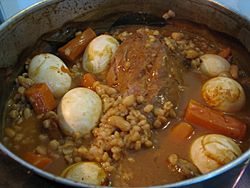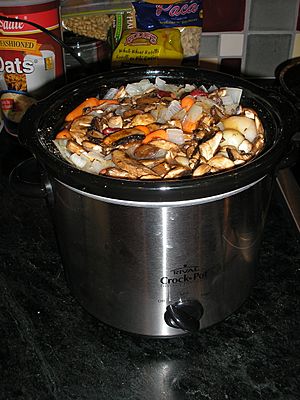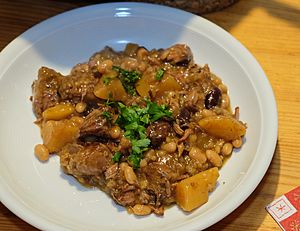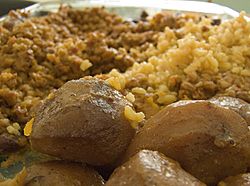Cholent facts for kids
 |
|
| Type | Stew |
|---|---|
| Main ingredients | Meat, potatoes, beans, barley |
Cholent (Yiddish: טשאָלנט, romanized: tsholnt or tshulnt) or hamin (Hebrew: חמין) is a special Jewish stew. It is cooked very slowly, often for 12 hours or more. People eat it for lunch on Shabbat, which is the Jewish day of rest.
Jewish law, called Halakha, says that you cannot cook on Shabbat. So, cholent was created to follow this rule. Families start cooking it on Friday before Shabbat begins. The pot then stays warm on a special hot plate or in a slow oven until Saturday. This way, the food is hot and ready to eat without any cooking on Shabbat itself.
Cholent started a very long time ago in ancient Judea. Over many centuries, different Jewish communities around the world made their own versions. The main ingredients are usually meat, potatoes, beans, and barley.
There are two main styles of cholent:
- Ashkenazi style: This often uses meat, potatoes, beans, and barley. Sometimes, it includes a special sausage called kishke or stuffed chicken neck skin called helzel.
- Sephardi style: This version might use rice or wheat and chickpeas instead of beans and barley. Chicken is often used instead of beef. A common addition is whole eggs cooked in their shells, which turn brown and delicious.
Cooking cholent slowly overnight helps all the flavors mix together. This gives the stew its unique and tasty flavor.
Contents
What's in a Name?
The word cholent might come from an old French word meaning "that which is hot." Some people think it comes from French words meaning "hot" and "slow." Another idea is that it comes from a Hebrew word meaning "that rested overnight." This refers to how Jewish families used to leave their cholent pots in the town baker's hot oven overnight.
The name hamin comes from the Hebrew word for "hot." This makes sense because the stew is always served hot. In Morocco, a similar dish is called sakhina (meaning "warm") or dafina (meaning "buried"). The name dafina also hints at the old practice of burying the pot in hot ashes to keep it warm.
A Special Shabbat Meal

Cholent or hamin is a very important hot meal for the midday Shabbat lunch. It's eaten by Jewish families from all over the world. Even Jewish families in Israel who are not very religious enjoy cholent. It is especially popular during the colder months.
Sometimes, cholent is served at special celebrations after Shabbat services. For example, it might be served at a kiddush (a light meal after synagogue) or at parties for a groom before his wedding.
Jewish law forbids starting a fire or cooking food on Shabbat. So, cholent must be prepared before Shabbat begins on Friday afternoon. The food is then kept warm using a fire that was lit before Shabbat. This way, families can enjoy a hot, delicious meal without breaking any rules.
Some ancient Jewish scholars even said that eating warm food on Shabbat was very important. This was partly to show a difference from another Jewish group, the Karaites. The Karaites believed that no fire should be burning in a Jewish home on Shabbat, even if it was lit before. But most Jewish people understood the law to mean you just couldn't start a fire on Shabbat.
A Long History
Cholent, originally called hamin, began in ancient Judea. It might have existed as far back as the time of the Second Temple period. Some historians believe it was created by the Pharisees, a Jewish group. They wanted to show that their way of understanding the Bible was correct. They believed you could keep a fire burning on Shabbat if it was lit before, unlike another group, the Sadducees, who ate cold food.
As Jewish people moved to different parts of the world, they created their own versions of the stew. These versions used ingredients available in their new homes. But the idea of a slow-cooked Shabbat stew stayed the same.
The Ashkenazi style of cholent was first written about in 1180. In many old Jewish towns, families would take their uncooked cholent pots to the local baker. The baker would put the pots in his oven, which was always hot. On Saturday mornings, families would pick up their perfectly cooked cholent. This same tradition happened in places like Morocco.
The special way cholent is cooked even inspired the invention of the slow cooker. Today, cholent is very popular in Israel. You can find restaurants called cholenterias that specialize in this stew.
Different Kinds of Cholent
There are many ways to make cholent, depending on where a Jewish family comes from.
- In places like Germany and the Netherlands, it's called schalet or shalent.
- Hungarian Jews adapted a local dish called sólet to be their Shabbat stew.
- Moroccan Jews call their Shabbat dish s’hina or skhina. It often has chickpeas, rice, potatoes, meat, and whole eggs.
- In Spain and North Africa, a similar dish is called adafina or dafina. It comes from an Arabic word meaning "buried."
- The Sephardic Jews of Jerusalem used to eat macaroni hamin, made with macaroni, chicken, and potatoes.
- Bukharan Jews make oshi sabo, a hot Shabbat dish with meat, rice, and fruit for a sweet and sour taste.
- Iraqi Jews have t'bit, which is a whole chicken skin stuffed with rice, chicken, and herbs.
- Indian Jews in Mumbai traditionally ate a similar dish with chicken, rice, and spices like ginger and turmeric.
- Ethiopian Jews eat Sanbat Wat, a kosher chicken stew with hard-boiled eggs and spices.
Ashkenazi Cholent Recipes
Many recipes for Ashkenazi cholent exist. The main ingredients are usually beans (often a mix of different kinds), grains (like barley), and beef (such as brisket). Other common additions are cooked onions and potatoes. The stew is seasoned with salt, pepper, garlic, and spices like paprika. Water is added to make it a thick stew.
While beef is traditional, some people use chicken, turkey, or even goose. Other vegetables like carrots or zucchini can be added. Some cooks add caramelized sugar or even beer for extra flavor.
A popular addition is kishke or helzel. Kishke is a sausage stuffed with a mixture of flour, fat, onions, and spices. Helzel is chicken neck skin stuffed with a similar mixture.
Sephardi Hamin Recipes
Sephardi-style hamin often includes whole, stuffed vegetables. Vegetables like tomatoes, green peppers, eggplant, and zucchini are filled with a mix of beef and rice. These are then placed in the pot with meat or chicken and chickpeas. Sephardim also add spices like cumin and hot peppers.
The ingredients and how spicy hamin is can change from place to place. Iraqi Jews make tebit with a whole chicken stuffed with rice. Jews from Morocco or Spain make adafina or dafina. This version uses spices like garlic, cinnamon, and ginger, along with whole eggs that turn brown and creamy.
Yemenite Jews have special breads like jachnun and kubaneh that are also cooked slowly for many hours.
A very popular Sephardi addition to hamin is haminados. These are whole eggs cooked in their shells within the stew. They turn a beautiful brown color during the long cooking. These brown eggs are shelled and served on top of the stew. Sometimes, tea leaves or onion skins are added to the water to dye the eggshells purple and the whites a light brown. This also gives the egg a smooth, creamy texture. In Israel, brown eggs are often eaten with other dishes like ful medames (mashed beans) or hummus (chickpea dip).
See also
 In Spanish: Cholent para niños
In Spanish: Cholent para niños
Images for kids







